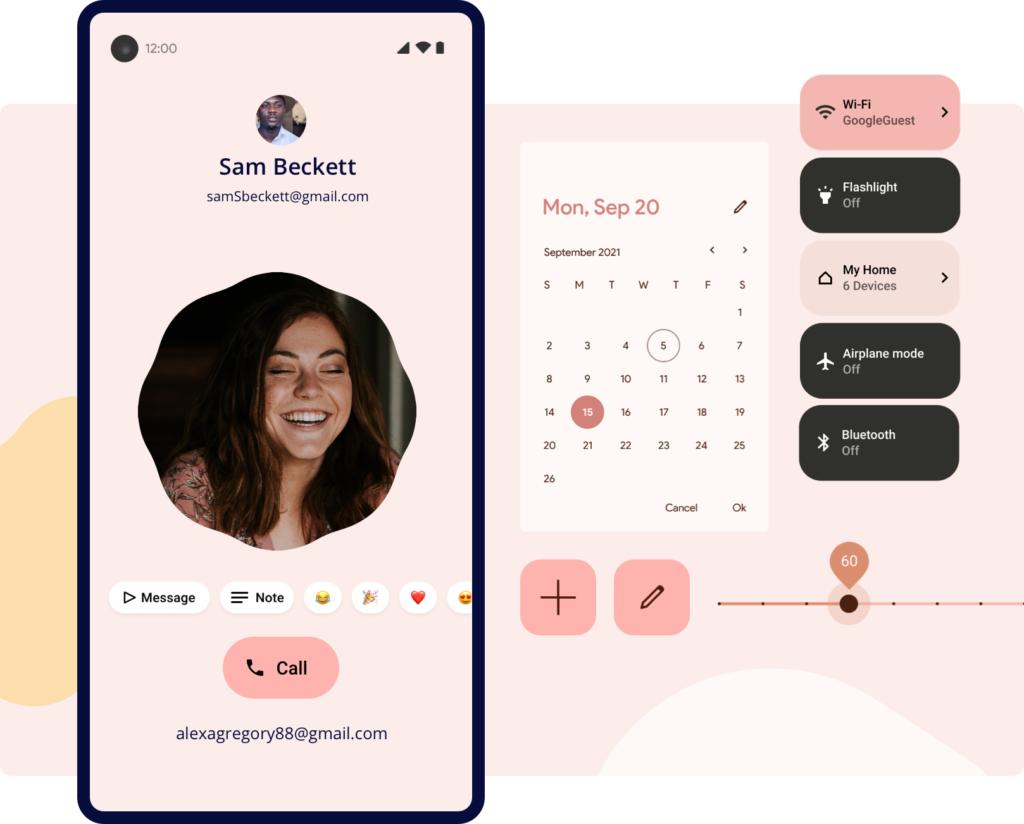Google I/O, the yearly developer conference of the organization, came back after the COVID-19 pandemic which was canceled last year. In this year’s I/O 2021 keynote, Google has launched the latest android version called ‘Android 12’.
Google upgrades the Android operating system with a full-scope hardware and software overhaul, a cornucopia of technology improvements and additions annually under their motto of “Innovation in the Open.”. Last year it launched Android 11 and now Android 12 has appeared this year through the First Developers Preview on February 18th, 2021.
The first beta, which provides access to the latest OS build, is now open to the public. A public beta version for Google’s Pixel Devices (Pixel 3 and above) is currently available and will also come to other vendors’ smart devices too. In Google’s Android beta section, you can enroll your android device or find detailed guidance on the Android Developers page for other supported devices.
In comparison with the previous developer previews, Android 12 Beta 1 is now online along with several updates than before and is still under improvement. That means that it’s still not ready for final customer use, but we’re just a couple of months away from it.
Sofy intends to supplement this guide with all the latest additions and technical changes that developers might be expecting in Android 12. (And if you’re confused about any of the terminology used in this post, check out the Sofy glossary here!)
Android 12 Beta 1 – Major changes and new features
-
Color extraction and visual overhaul: ‘Material You’ UI
This update for Android 12 will consequently extract a bunch of correlative color pallets for the system user interface depending on the tones utilized in the phone’s present wallpaper. Now, the users can have a new design that never compromises accessibility, granting transformative control of color tones, contrast, shading, size, line widths, and much more.
The user interface has been updated and motivated by ‘Material You’. Material You is a new variation of material design and has an advanced and better approach for theming Android. Using ‘Material You’, the applications can adapt comfortably and give users the entire transformation control at their fingertips. Moreover, there is a mode for each mood and can be seamlessly adapted across the associated applications and devices. However, the developers developing the android apps need to keep their application highly adaptable to withstand the changing color, theme, element placement changes on the device.
-
More control on Activity with a Privacy Dashboard
Android 12 features a Privacy Dashboard that gives information to users on how applications (both third-party and Google-owned apps) access their data and when. The user will have to open the Privacy Dashboard to see a detailed synopsis at a single place that shows them an overview of the number of applications that have accessed their camera, location, and microphone in the previous day. The users will also get an option to change application permissions. They can tweak them from the Manage Permissions setting on the timeline view page and revoke any particular permission from any installed application.
Moreover, the developers can provide more transparent access with their apps to the customers by showing a notification for the data access through the camera, microphone, and other sensors. Also, sometimes the customers have to switch off the previously activated permissions for the app. At such times, the process of allowing and denying access can be overwhelming. Developers can now give a specialized toggle switch to change the access of certain apps on the device.
-
App Hibernation to manage the footprint of unused apps
The “app hibernation” feature will strip an unused application of its authorizations and clear the impermanent cache or files acquired by that application. App Hibernation feature will hibernate all the applications that aren’t being used. This implies that just those applications which are in use will utilize your device battery. It will also limit the notifications for these applications.
This feature will be accessible to Android clients through a toggle in the “App Info” part of each application. The feature won’t prove beneficial for those having android devices with tones of storage and ram. However, it will probably be a big feature upgrade to the performance of entry-level or old android devices.
-
Safe partition within the OS using Private Compute Core
Android 12’s new Private Compute Core will be a special partition inside the OS, similar to the segments utilized for passwords or delicate biometric information. Yet, rather than holding accreditations, the Private compute core will hold data for use in artificial intelligence and machine learning, similar to the data utilized for the Smart Reply instant message feature or the Now Playing highlight for distinguishing songs.
Having a different partition for the data will make it simpler for the OS to protect it, and keeping it safe, private, and local to your own device while keeping it accessible for system-level functions at the same time. The developers using this feature will be able to provide more customized message responses and the Smart Reply Instant feature gets even better and personalized as its algorithm learns the user behavior on the run.
-
App pairs to increase productivity with app multitasking
For Android 12, Google has been working to deal with a pair of applications together as one while performing various tasks with multi-window mode. It could prove to be beneficial for the two; tablets and Android foldable. Android Split Screen as of now permits the users to utilize two applications at once, yet with Android 12, another feature called “App Pairs,” will permit customers to open two applications that are commonly used together simultaneously. This feature pairs two applications together as one single task.
With App Pairs, the users can pick two recently opened applications and make them a pair. When those applications are paired, users can then effectively switch between a single application and a pair. The developers need to focus on the how the maximum productivity can be juiced out of this feature. They can integrate certain gestures to control the app pairs and add certain functionalities such as Picture in Picture (PiP) mode, app area sliders and others depending upon the type and requirement of the application.

What should the developers expect with the Android 12 update?
-
Developers can easily create effects
There had been numerous enhancements to application bandwidth estimations in the Android 12 update. The picture-in-picture (PiP) control can be dealt with via a single tap on a PiP window to display the window controls. If the user double-taps a PiP window- it toggles between the current and the largest PiP size. Henceforth, the developers will have a simpler time creating color and shading filters, producing blurs and other effects.
-
Developers can take advantage of Easy Sharing
In the previous versions of Android, it was very simple to share a Wi-Fi connection by utilizing a QR code. But, the QR code worked fine only when a user is close to you so that they can scan the code. Using Android 12, the developers can take advantage of the new feature Nearby Share. The users can send Wi-Fi configuration (password or SSID) utilizing Bluetooth to nearby devices. The recipient must be inside the Bluetooth range to enable Nearby share.
-
Developers can improve the audio effects using haptic feedbacks
The developers can combine the haptic feedback pattern with audio after the Android 12 update. It couldn’t just prove beneficial in games, but the capacity of users to recognize callers in light of haptic feedback. The incorporation of haptic feedback will also enhance the experience of listening to music.
-
Developers can integrate visual components in their applications
One of the most important features in Android 12 is the AVIF picture support. This new image format will extraordinarily improve the compression of images without affecting the quality of the image. That implies that the users can transmit larger image documents, utilizing less bandwidth. This feature is a boon for users who like to consume images. It additionally implies that the developers can coordinate significantly more visual elements into their applications without causing bottlenecks, buffering, or excess data consumption issues.
The Verdict
With this major update in Android’s operating system, customers need to update the applications to support the changes and features that Android 12 offers. To take advantage of this new update, it is crucial for the developers to execute quality assurance tests to eliminate any bugs or irregularities that can hinder the functions or sabotage the compatibility of an application or lead to security issues.









